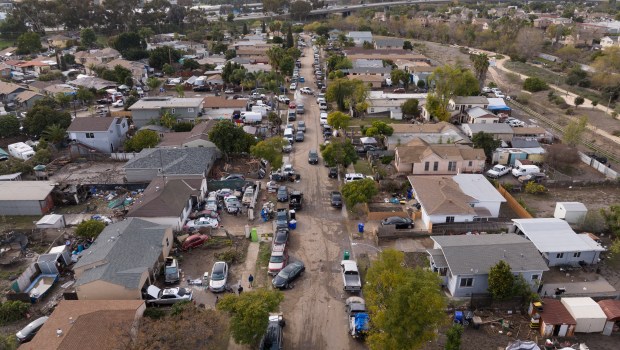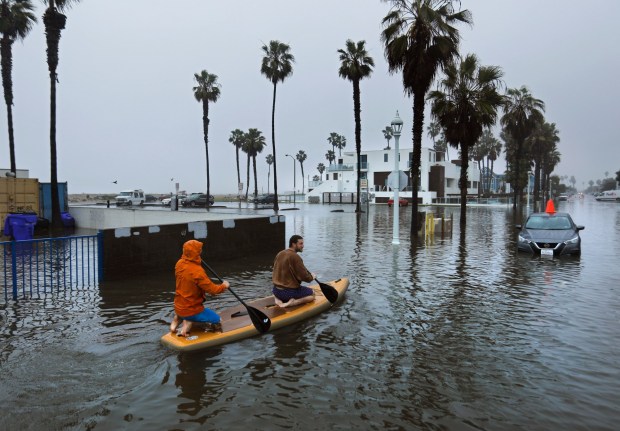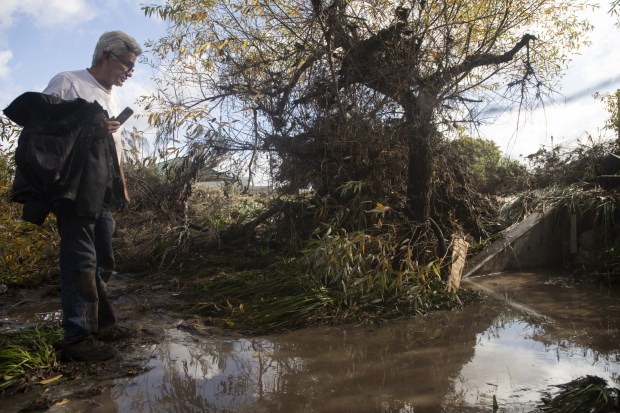The San Diego City Council last week approved a five-year insurance plan that is expected to cost a quarter-billion dollars or more over the life of the contract, including almost $50 million in the new fiscal year that begins July 1.
The agreement passed without any serious questions from the elected officials.
But the insurer — a joint-powers authority called Public Risk Innovation, Solutions and Management, or PRISM — has yet to pay any damages to city residents whose lives were upended by January 2024 flooding.
“The action before us is going to save us significant amounts of money as we move forward,” Councilmember Raul Campillo said moments before the unanimous vote on Tuesday.
 On Wednesday, January 24, 2024, the residents on Beta Street begin the cleanup after their homes were severely effected by the recent flood damage during Monday’s rain storm causing the flood channel to over flow. (Nelvin C. Cepeda / The San Diego Union-Tribune)
On Wednesday, January 24, 2024, the residents on Beta Street begin the cleanup after their homes were severely effected by the recent flood damage during Monday’s rain storm causing the flood channel to over flow. (Nelvin C. Cepeda / The San Diego Union-Tribune)
Campillo and his eight council colleagues all declined to discuss the nearly $1 million-a-week contract. Not one of the elected officials responded to questions about the value of the PRISM policy in light of the fact that it has not paid damages to victims.
Mayor Todd Gloria and City Attorney Heather Ferbert both declined to say whether the city has even filed an insurance claim. They also would not discuss whether they expect PRISM to invoke any of the policy’s many exclusions.
“This is in fact related to litigation, I’m told,” Gloria spokesperson Rachel Laing said by email. “The city attorney might be able to provide more information.”
The City Attorney’s Office declined to do so. “To your first question, we are unable to comment on pending litigation,” spokesperson Ibrahim Ahmed wrote. “To your second question, we don’t have any comment on the policy.”
The San Diego Union-Tribune requested copies of any flood-related claims the city had submitted, along with letters of coverage — statements from insurers that spell out which claims are covered and which are not.
Both offices declined to release any flood-related records.
 Flooding in many parts of San Diego in January 2024 showed huge problems with city storm infrastructure. Above, Kolby Qualls, front, and Evan Anderson paddle across a flooded Abbott Street in Ocean Beach after a powerful storm. (K.C. Alfred / The San Diego Union-Tribune)
Flooding in many parts of San Diego in January 2024 showed huge problems with city storm infrastructure. Above, Kolby Qualls, front, and Evan Anderson paddle across a flooded Abbott Street in Ocean Beach after a powerful storm. (K.C. Alfred / The San Diego Union-Tribune)
Like many local government agencies, the city of San Diego is primarily self-insured. That means the city pays routine claims in cases like slip-and-fall accidents or crashes involving city vehicles from its own revenue.
But San Diego also participates in a pooled insurance program designed to cover catastrophic events.
The PRISM coverage in effect that day can pay up to $50 million — money that could be used to provide badly needed help to thousands of flood victims. Under the policy, the city is responsible for spending the initial $5 million before it can seek reimbursement.
But San Diego has declined to provide virtually any financial help to flood victims, their lawyers said.
“We try to get a deal done with the city, but the city is completely uninterested in helping the flood victims,” attorney Evan Walker said. “The city has turned its back on the very people it’s supposed to help.”
Most of his clients are not wealthy people, Walker said.
They are working families, seniors and small-business owners who lost most everything they owned one day last year, and most are still living in water-damaged homes — or displaced because their homes are uninhabitable.
“The city keeps dragging this litigation out, as if time doesn’t matter,” Walker said.
Over recent weeks, in fact, the city has gone on offense. San Diego has begun filing countersuits against up to 1,000 people and businesses — both named and unnamed — accusing them of contributing to the flood.
The city “expressly denies liability for the plaintiffs’ claims,” city lawyers wrote, “but in the event that cross-complainant is held liable to plaintiffs, such liability will be the result of, and caused by, the negligence, carelessness, acts or omissions of cross defendants.”
Michael Aguirre, the former elected San Diego city attorney who is now representing some of the flood victims, said he and his colleagues were led to believe last year that San Diego would not contest liability for the flood.
“The city is not willing to maintain the storm system to prevent damages, and they are not willing to pay for the damage they caused by failing to maintain the system,” he said. “They are leaving the victims stranded with no source of recovery.”
 Greg Montoya, 68, looks at a clogged storm drain after heavy rain Monday caused flooding near Birch and Una Streets in Southcrest on Jan. 23, 2024 in San Diego, California. Montoya was part of a lawsuit against the City that was filed in 2019 after other flooding issues. Montoya said he emailed the City last week telling them that storm drains were clogged and needed to be cleaned. (Ana Ramirez / The San Diego Union-Tribune)
Greg Montoya, 68, looks at a clogged storm drain after heavy rain Monday caused flooding near Birch and Una Streets in Southcrest on Jan. 23, 2024 in San Diego, California. Montoya was part of a lawsuit against the City that was filed in 2019 after other flooding issues. Montoya said he emailed the City last week telling them that storm drains were clogged and needed to be cleaned. (Ana Ramirez / The San Diego Union-Tribune)
Abraham Stapleton, one of the many flood victims now suing the city, can’t understand why San Diego officials haven’t done more to help people whose lives were thrown upside down.
A renter whose apartment was overwhelmed by storm runoff, Stapleton estimated his losses at more than $60,000 — not including some $13,000 in new, high-interest debt.
“When I had to move, I didn’t have anything,” he told the Union-Tribune this past week. “So I had to rack up credit cards, and they just have been eating me alive for the last 18 months. I can’t get past them.”
Meanwhile, because the $50 million cap on damages includes litigation costs, every dollar the city spends to defend the lawsuits is money it cannot provide in flood relief.
Dozens of exclusions
Public Risk Innovation, Solutions and Management was created in 1979 by a handful of California counties working to shield themselves from outsized insurance claims that could push them into bankruptcy.
The risk-sharing pool quickly added more agencies, and today PRISM represents more than 360 cities, counties, schools and special districts.
Based in the Sacramento suburb of Folsom, the pooled-risk insurance plan raises and spends more than $2 billion a year providing risk-management services, insurance and reinsurance, and training and consulting to member agencies.
The joint-powers authority is a public agency, with a board of directors made up of one appointee from each of the 55 member counties and seven others. The San Diego County appointee is Brad Rankin, the county’s human resources deputy director.
PRISM did not respond to questions about San Diego’s flood insurance coverage last week. Chief operating officer and general counsel Michael Pott said he could not discuss any claim or provide any records related to a claim.
In seeking the PRISM renewal, San Diego risk managers told council members that the policies include general liability, property, cyber liability, employee crime and dishonesty, pollution liability and watercraft and aviation coverage.
The 2025-26 contract costs $47.4 million, according to the staff report, meaning the five-year arrangement would cost up to $250 million — not including any annual premium increases.
The mayor’s risk managers also stressed that they and the city’s legal team work closely with PRISM staff to resolve pending litigation.
“These relationships are essential in order to manage excess liability cases efficiently and in compliance with PRISM’s claims administration standards until claims are closed or a settlement is reached,” the report to the council said.
Still, it is not clear whether the policy in effect on Jan. 22, 2024, would cover the damages from that day’s flooding.
The memorandum of coverage for the general liability policy PRISM issued the city includes 28 separate exclusions and dozens of sub-exclusions, at least some of which appear to allow the insurer to limit or avoid paying damages.
Specifically, one clause allows the insurer to deny coverage in cases involving “the actual or threatened discharge, dispersal, seepage, migration, release or escape of pollutants.” Another raises the question of subsidence, which relates to the caving in or sinking of land.
Another exclusion cites “liability, directly or indirectly, arising out of or in connection with the principles of eminent domain, condemnation proceedings or inverse condemnation,” according to the memorandum, a copy of which was obtained by the Union-Tribune.
Inverse condemnation — a legal concept under which plaintiffs argue that their property was illegally taken or damaged by the government — is one of multiple causes of action alleged in the flood litigation. The idea is that government action or inaction caused their losses.
Tom Corringham is a research economist at the Scripps Institution of Oceanography who studies the economic impact of climate change and extreme weather events. After reviewing the PRISM declarations, several issues jumped out at him.
“The policy includes an extensive list of exclusions, particularly for flood-related claims,” he said. Also, “the city must cover costs up to its self-insured retention and then seek reimbursement for eligible claims — assuming they’re not excluded.”
Corringham said pooled insurance plans can work for routine government liabilities but struggle in the face of systemic risk.
The most effective long-term solution is to reduce the impacts of climate change by investing more in climate-resilient infrastructure, he said.
“When high-impact, low-frequency weather events like the January 2024 flooding occur, they can expose gaps in protection, especially if they trigger exclusions,” he said. “If we can increase our resilience, then we can limit the increases in premiums.”
 Garbage and other debris from Monday’s flooding are seen piled up in Chollas Creek in Southcrest on Friday, Jan. 26, 2024. City workers have started clearing out the creek at South 38th Street and will work upstream. (Kristian Carreon / For The San Diego Union-Tribune)
Garbage and other debris from Monday’s flooding are seen piled up in Chollas Creek in Southcrest on Friday, Jan. 26, 2024. City workers have started clearing out the creek at South 38th Street and will work upstream. (Kristian Carreon / For The San Diego Union-Tribune)
Failing infrastructure
One of the most critical allegations that San Diego flood plaintiffs have made in their lawsuits is that the city has for years failed to properly maintain its stormwater system.
The accusation is backed up by years of internal and independent studies that have warned Gloria and previous mayors that they need to do more to protect people from the threat posed by flooding.
“The city’s stormwater infrastructure, most of which was built in the 20th century, is past its useful life, resulting in system deterioration and failure,” city officials wrote in a formal report published in 2022.
Only weeks before Chollas Creek badly overflowed, another report warned that danger was looming.
“Age, combined with deferred maintenance due to historic underfunding of the storm drain system, poses a risk of flooding and catastrophic failure,” that five-year planning outlook said.
In all, San Diego’s so-called infrastructure deficit has swelled past $5 billion — the estimated cost of upgrading city systems to an acceptable or adequate standard. Almost half of that is due to delayed and deferred stormwater upgrades.
The problem is growing worse.
Less than a decade ago, the stormwater infrastructure deficit was estimated at $416 million if the needed upgrades were completed between 2017 and 2022.
They were not. The gap now exceeds $2.2 billion.
City officials said the projected needs had grown in part because assessments are more comprehensive than they used to be. And because much of the infrastructure was built in the 1950s and 1960s, it’s now reaching the end of its expected lifespan.
San Diego oversees about 200 segments of flood channels, including those along Chollas Creek that overflowed, according to a 2023 report. That year, nearly one-third of all those channels needed “substantial maintenance,” stormwater officials told the City Council in that study.
Earlier this month, the growing stormwater needs led council members to add more than $757,000 in contingency flood-control funding to next year’s budget before they approved it on a 7-2 vote.
Last week, Gloria stripped it from the 2025-26 spending plan.
“The mayor remains committed to investing in critical stormwater infrastructure, which has long been overlooked,” his office said. “This contingency funding lacked an identified need at this time — and would not result in any new construction of stormwater projects.”
The City Council will consider whether to override the veto Monday.
